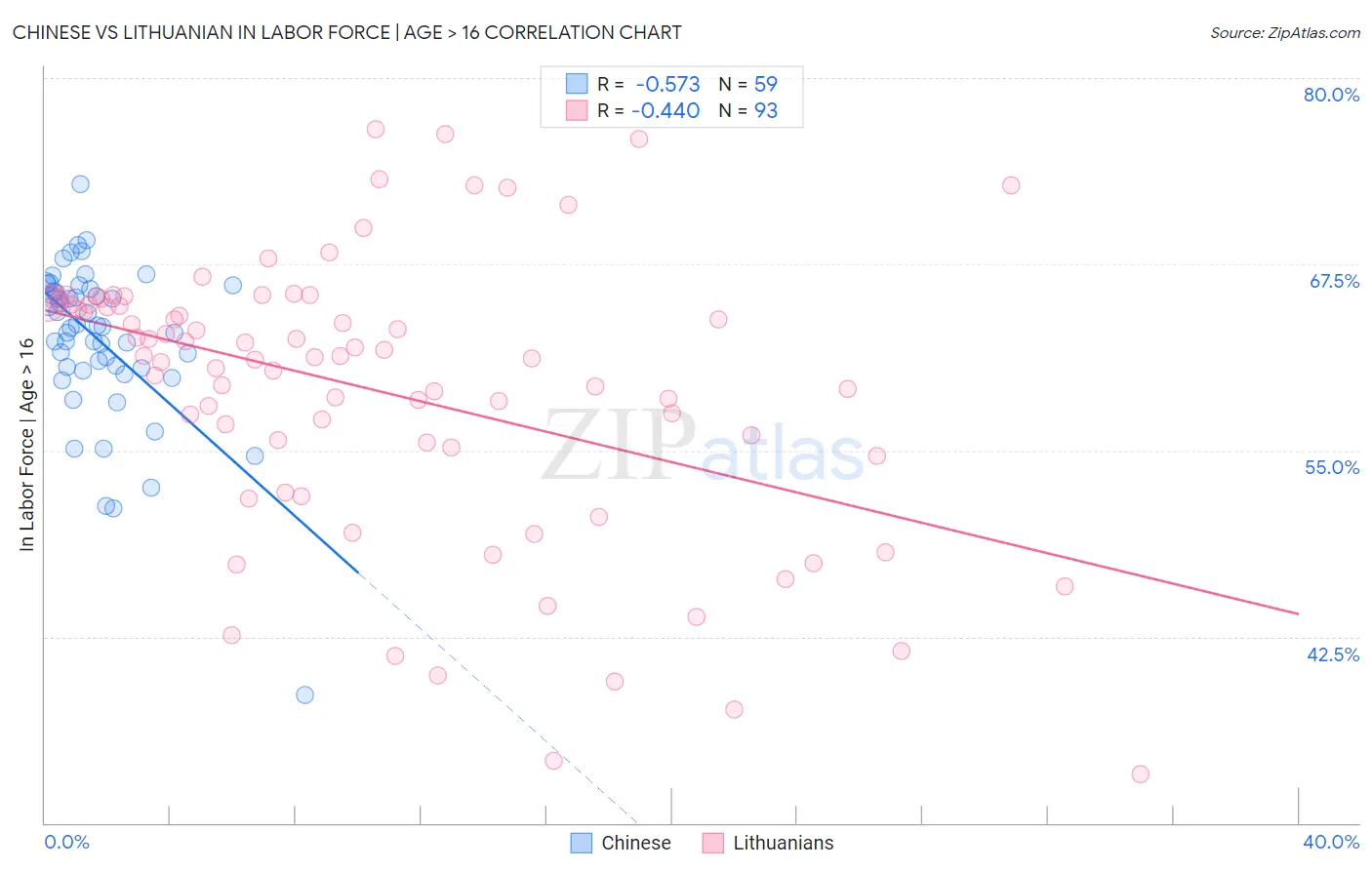Chinese vs Lithuanian In Labor Force | Age > 16
COMPARE
Chinese
Lithuanian
In Labor Force | Age > 16
In Labor Force | Age > 16 Comparison
Chinese
Lithuanians
64.7%
IN LABOR FORCE | AGE > 16
7.3/ 100
METRIC RATING
230th/ 347
METRIC RANK
64.8%
IN LABOR FORCE | AGE > 16
17.4/ 100
METRIC RATING
206th/ 347
METRIC RANK
Chinese vs Lithuanian In Labor Force | Age > 16 Correlation Chart
The statistical analysis conducted on geographies consisting of 64,809,883 people shows a substantial negative correlation between the proportion of Chinese and labor force participation rate among population ages 16 and over in the United States with a correlation coefficient (R) of -0.573 and weighted average of 64.7%. Similarly, the statistical analysis conducted on geographies consisting of 421,961,459 people shows a moderate negative correlation between the proportion of Lithuanians and labor force participation rate among population ages 16 and over in the United States with a correlation coefficient (R) of -0.440 and weighted average of 64.8%, a difference of 0.28%.

In Labor Force | Age > 16 Correlation Summary
| Measurement | Chinese | Lithuanian |
| Minimum | 38.6% | 33.3% |
| Maximum | 72.9% | 76.6% |
| Range | 34.3% | 43.3% |
| Mean | 62.4% | 59.0% |
| Median | 63.3% | 61.2% |
| Interquartile 25% (IQ1) | 60.5% | 54.9% |
| Interquartile 75% (IQ3) | 65.9% | 64.8% |
| Interquartile Range (IQR) | 5.4% | 9.9% |
| Standard Deviation (Sample) | 5.4% | 9.4% |
| Standard Deviation (Population) | 5.4% | 9.4% |
Similar Demographics by In Labor Force | Age > 16
Demographics Similar to Chinese by In Labor Force | Age > 16
In terms of in labor force | age > 16, the demographic groups most similar to Chinese are British (64.7%, a difference of 0.0%), Immigrants from Northern Europe (64.7%, a difference of 0.0%), European (64.7%, a difference of 0.040%), Polish (64.7%, a difference of 0.040%), and Northern European (64.7%, a difference of 0.040%).
| Demographics | Rating | Rank | In Labor Force | Age > 16 |
| Immigrants | Belize | 9.2 /100 | #223 | Tragic 64.7% |
| Immigrants | Jamaica | 8.8 /100 | #224 | Tragic 64.7% |
| Croatians | 8.8 /100 | #225 | Tragic 64.7% |
| Europeans | 8.3 /100 | #226 | Tragic 64.7% |
| Poles | 8.3 /100 | #227 | Tragic 64.7% |
| Northern Europeans | 8.2 /100 | #228 | Tragic 64.7% |
| British | 7.3 /100 | #229 | Tragic 64.7% |
| Chinese | 7.3 /100 | #230 | Tragic 64.7% |
| Immigrants | Northern Europe | 7.2 /100 | #231 | Tragic 64.7% |
| Africans | 5.8 /100 | #232 | Tragic 64.6% |
| Slavs | 4.9 /100 | #233 | Tragic 64.6% |
| Vietnamese | 4.7 /100 | #234 | Tragic 64.6% |
| Austrians | 4.6 /100 | #235 | Tragic 64.6% |
| Immigrants | Norway | 4.6 /100 | #236 | Tragic 64.6% |
| Italians | 4.6 /100 | #237 | Tragic 64.6% |
Demographics Similar to Lithuanians by In Labor Force | Age > 16
In terms of in labor force | age > 16, the demographic groups most similar to Lithuanians are Immigrants from Latin America (64.8%, a difference of 0.020%), Belizean (64.8%, a difference of 0.020%), Russian (64.9%, a difference of 0.030%), Slovene (64.9%, a difference of 0.030%), and Jamaican (64.9%, a difference of 0.030%).
| Demographics | Rating | Rank | In Labor Force | Age > 16 |
| Mexican American Indians | 23.1 /100 | #199 | Fair 64.9% |
| Armenians | 20.2 /100 | #200 | Fair 64.9% |
| Ukrainians | 19.6 /100 | #201 | Poor 64.9% |
| Immigrants | Belgium | 19.4 /100 | #202 | Poor 64.9% |
| Russians | 18.8 /100 | #203 | Poor 64.9% |
| Slovenes | 18.7 /100 | #204 | Poor 64.9% |
| Jamaicans | 18.7 /100 | #205 | Poor 64.9% |
| Lithuanians | 17.4 /100 | #206 | Poor 64.8% |
| Immigrants | Latin America | 16.4 /100 | #207 | Poor 64.8% |
| Belizeans | 16.2 /100 | #208 | Poor 64.8% |
| Immigrants | Trinidad and Tobago | 15.6 /100 | #209 | Poor 64.8% |
| Immigrants | Denmark | 14.7 /100 | #210 | Poor 64.8% |
| Fijians | 14.1 /100 | #211 | Poor 64.8% |
| Alaskan Athabascans | 13.9 /100 | #212 | Poor 64.8% |
| Maltese | 13.8 /100 | #213 | Poor 64.8% |